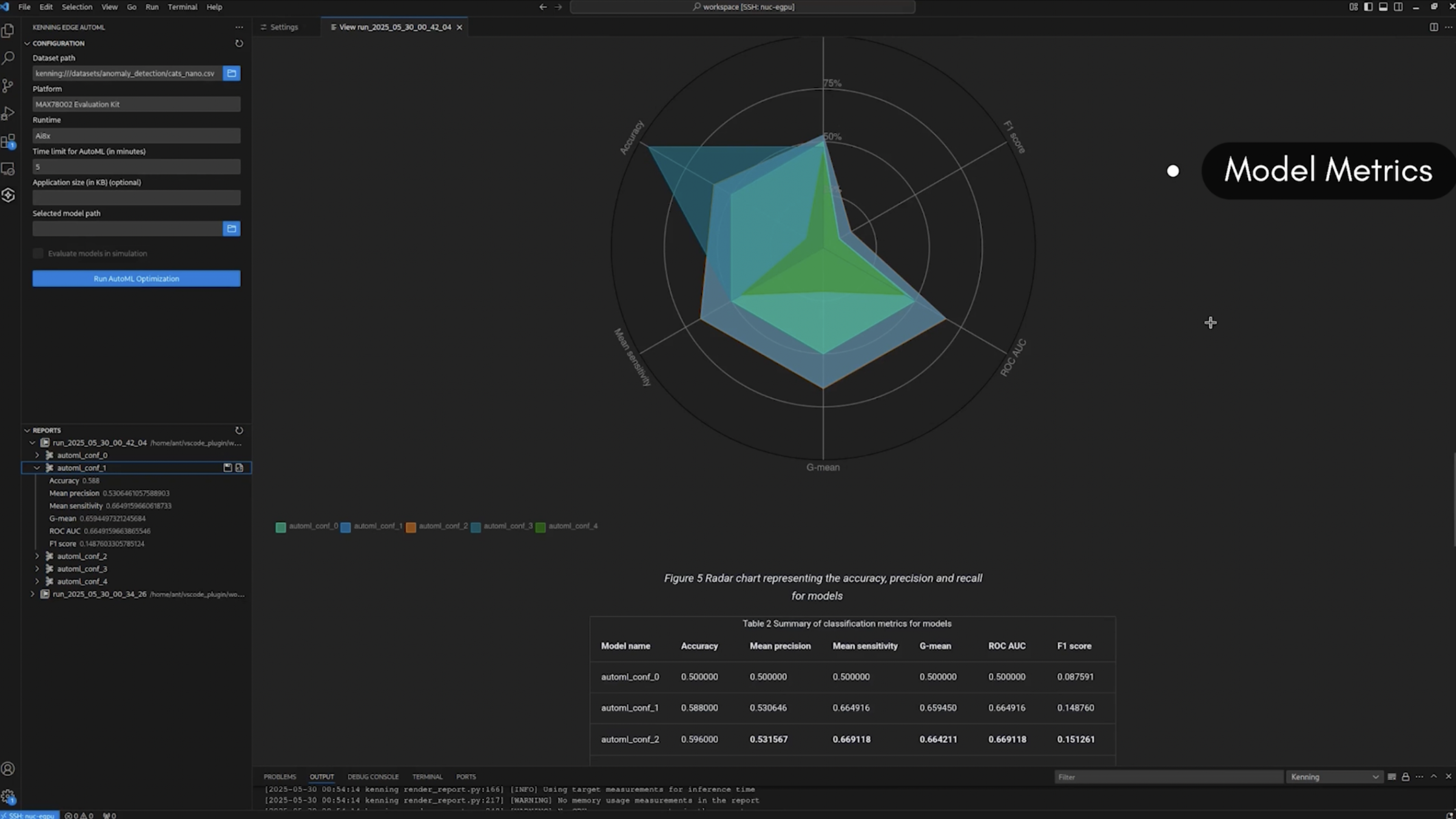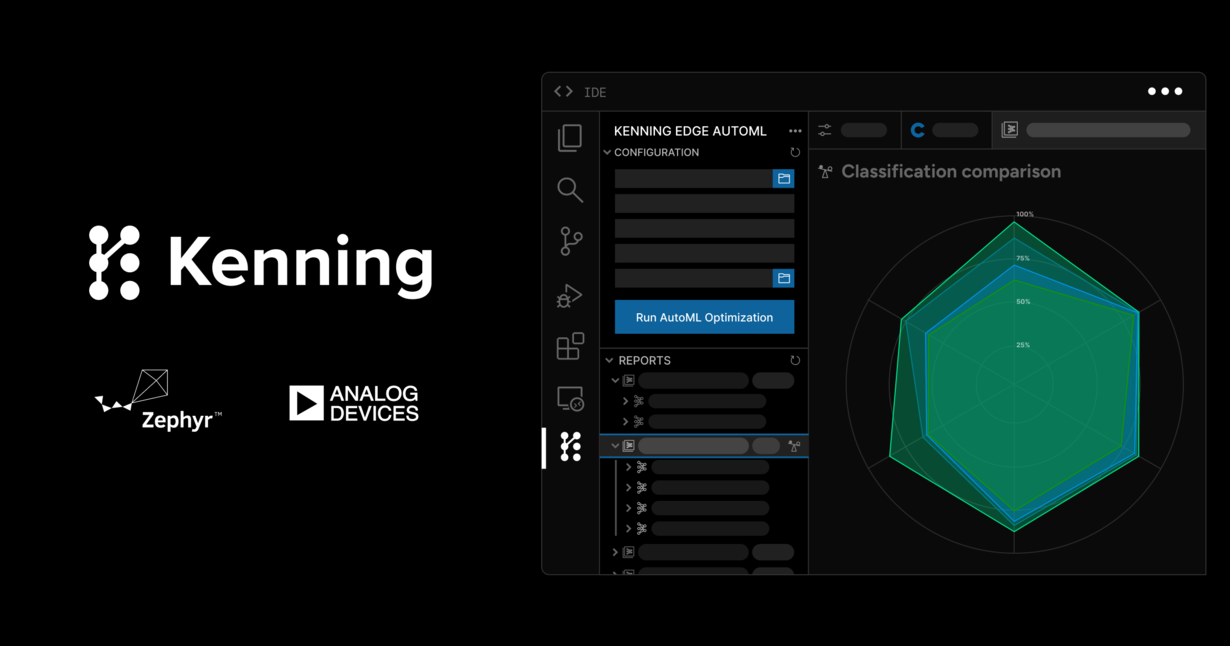Originally published on 14th July 2025 by Analog Devices, Inc (ADI)
Accelerating Edge AI Innovation
AI is rapidly moving to the edge with demand for intelligent edge devices exploding, but many developers still struggle to fit powerful models onto tiny microcontrollers. Developers face a steep learning curve, as they juggle data preprocessing, model selection, hyperparameter tuning and hardware-specific optimizations. Now imagine building and deploying robust, resource-intensive machine learning models on edge devices like microcontrollers and other constrained platforms, without wrestling with complex code or hardware constraints.
Today, we’re thrilled to introduce AutoML for Embedded, co-developed by Analog Devices, Inc. (ADI) and Antmicro, now available as part of the Kenning framework, a hardware-agnostic and open-source platform for optimizing, benchmarking, and deploying AI models on edge devices. AutoML for Embedded is built to make edge AI accessible, efficient and scalable for everyone from embedded engineers to data scientists.
AutoML for Embedded changes the game. By automating the end-to-end machine learning pipeline, it empowers less-experienced developers to build high-quality models and helps experts accelerate experimentation. The result? Lightweight, efficient models that deliver robust performance, without exceeding your device’s limits.

Seamless Integration with CodeFusion Studio™ and ADI Hardware
AutoML for Embedded is a Visual Studio Code plugin built on the Kenning library, designed to fit naturally into your existing workflow. It integrates with CodeFusion Studio™ and supports:
- ADI MAX78002 AI Accelerator MCUs & MAX32690: Deploy models directly to industry-leading edge AI hardware.
- Simulation & RTOS Workflows: Leverage Renode-based simulation and Zephyr RTOS for rapid prototyping and testing.
- General Purpose, Open-Source Tools: Enables flexible model optimization without platform lock-in
With step-by-step tutorials, reproducible pipelines, and example datasets, you can go from raw data to edge AI deployment in record time—no data science expertise required.
Built for Developers, Backed by Industry Leaders
AutoML for Embedded is the result of a close collaboration between ADI and Antmicro, combining deep hardware expertise with open-source innovation. Our mission is to deliver open, user-centric and extensible tooling that accelerates the adoption of edge AI across industries.
“Building on the flexibility of our open-source AI benchmarking and deployment framework, Kenning, we were able to develop an automated flow and VS code plugin that vastly reduces complexity of building optimized edge AI models,” said Michael Gielda, VP Business Development at Antmicro. “Enabling workflows based on proven open-source solutions is the backbone of our end-to-end development services that help customers take full control of their product. With flexible simulation using Renode and seamless integration with the highly configurable and standardized Zephyr RTOS, the road to transparent and efficient edge AI development using AutoML in Kenning is open.”
How It Works: Under the Hood
AutoML for Embedded automates model search and optimization using state-of-the-art algorithms. It leverages SMAC (Sequential Model-based Algorithm Configuration) to efficiently explore model architectures and training parameters and applies Hyperband with Successive Halving to focus resources on the most promising models. It also verifies model size against device RAM to enable successful deployment.
Candidate models can then be optimized, evaluated and benchmarked using Kenning’s standard flows, with detailed reports on size, speed and accuracy to guide deployment decisions.
Real-World Impact: Use Cases
AutoML for Embedded is already transforming how developers approach edge AI. For example, in a recent demonstration, the tool was used to create an anomaly detection model for sensory time series data on the ADI MAX32690 MCU. The model was deployed both on physical hardware and its digital twin in Renode simulation, showcasing seamless integration and real-time performance monitoring.
Other potential applications include:
- Image classification and object detection on low-power cameras
- Predictive maintenance and anomaly detection in industrial IoT sensors
- Natural language processing for on-device text analysis
- Real-time action recognition in sports and robotics
Get Started Today
AutoML for Embedded is available now on Visual Studio Code Marketplace and GitHub
AutoML for Embedded in Visual Studio Marketplace AutoML for Embedded on GitHub
We invite you to explore the tool, share your feedback, and help shape the future of edge AI.
Interested in bringing AutoML for Embedded to your application? We’re actively looking for customers who want to explore what’s possible at the edge. If you’re building with AI and want support optimizing or deploying your models on embedded devices, we’d love to hear from you.
Visit the developer portal to learn more about how we can support your project.
To learn more about Antmicro’s engineering services for developing AI-enabled embedded systems using open source tools such as Kenning and Renode, reach out to us at contact@antmicro.com.


